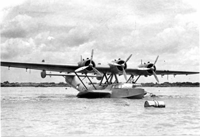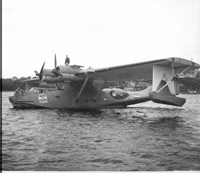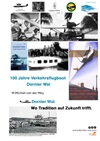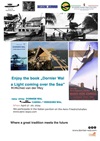| |
After Pearl Harbor the war came also to South East Asia and the Dutch joined the American war effort even before the British did and had to pay a heavy toll. In this conflict the flying boats did their duty and it is obvious that besides the patrol role they were also used in search and rescue roles.
On patrol over the western approaches of the Java Sea on February 19th, 1942 the Dutch Dornier Do 24K flying boat X-28 discovered 28 survivors of the bombed merchant vessel Sloet van de Bele. On February 20th, the damaged Do 24 K flying boat X-16 saved 34 survivors from the escorting Dutch destroyer HNLMS Van Nes and a further 41 from the Sloet van de Bele. On the same day the X-18 succeeded in picking up another 34 survivors from the Sloet van de Bele and flew them to the port of Batavia (Djakarta) Tandjong Priok. The rescue efforts continued and the following day the X-18 made another successful rescue flight. On February 21st, the Dutch Naval Aviation Catalina Y-45 rescued on one flight no less than 79 survivors of the Sloet van de Bele! (Photo: Do 24K Dutch Naval Air Station Morokrembangan (Archive Prudent Staal)) |
|
 |
I am not aware of any other Catalina that rescued so many people on one flight. During those terrible days a total of 320 survivors of the bombed Sloet van de Bele and Van Nes were saved by flying boats. Had the flying boats been able to come to the rescue sooner, many more could have been saved. We are however referring to an extremely critical wartime situation in which Dutch rule was rapidly coming to an end.
Better known is the fact that in the Second World War thousands of mariners, sailors and airmen from all belligerent parties were saved by flying boats from the different sides. In the beginning of the war the standard German SAR aircraft was still the old He 59 of which there were only a handful. On the German side the Do 18 and Do 24’s role changed in the course of the war from maritime patrol in Norway and the Black Sea to Search and Rescue. The few operational German Do 24’s were integrated in the Luftwaffe. After the occupation of the Netherlands in May 1940 Germany took possession of the Dutch Do 24’s under construction together with their engines and the complete production-line for the production of the boats at Aviolanda in Papendrecht close to Rotterdam. During the occupation Aviolanda delivered more than 24 complete Do 24’s to the Luftwaffe.
On one of my numerous research travels for my book on the worldwide history of the Dornier Wal (Dornier Wal - A Light Coming Over the Sea ISBN 88-87621-64-0 ), I had the privilege to meet the founder of the German SAR, the Cap Hornier (Cape Horn sailor) Karl Born (1910 – 2004) personally on several occasions. He once told me that the seizure of the Aviolanda yard was good fortune for German aviation as the Luftwaffe had not been too interested in the Do 24 concept. On July 19th,1940 in his capacity as Commanding Officer of the 4 Seenotstaffel (SAR), Karl Born accepted the first Aviolanda-built all-white SAR Do 24, the second following on August 2nd. In the course of the war they were repainted in Luftwaffe colours. From November 1944 onwards Karl Born was in charge of the remnants of the SAR squadrons – Seenotgruppe 81 (SAR-Group 81) - in the North Sea, Baltic, Norway and Denmark with its headquarters in Bug on Rügen. (Photo: PBY5 Y-45 (Archive Prudent Staal)) |
|
 |
From early-1945 until hours before the unconditional capitulation started, arguably the most impressive action of the German Navy and Air Force in WW II occurred: the large scale evacuation of two million civilians from East Prussia, Pommern and West Prussia. In these weeks the Do 24 flying boats of the Seenotgruppe 81 rescued some thousands of children from the encircled town of Köslin. One of the boats with Karl Born at the helm carried 99 (!) children and 17 adults to Rügen. The SAR operations of Karl Born’s ended spectacularly as, after hard negotiations, he got permission from the RAF to assemble all of the 15 Do 24’s of the Seenotgruppe 81 in Schleswig. Almost two months after the capitulation on June 30th, 1945, Karl Born’s 15 Luftwaffe Do 24’s with large red crosses painted on the hulls and escorted by RAF Typhoon fighters, landed in perfect order in Schleswig!
I am recalling this story in order to draw attention to cheaper alternatives to satellites for patrolling the outside sea borders of the European Union. We all know the flying boat disappeared in the fifties, but new materials may now keep the natural enemy of the flying boat – corrosion - in check and this makes a renaissance in the interesting niche market of flying boats possible. |
|




